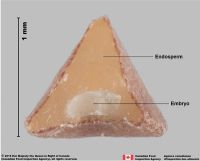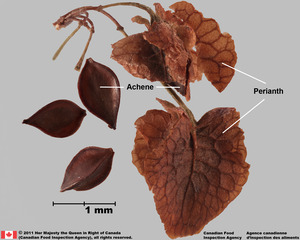Content is from Kirkbride et al. 2006Kirkbride et al. 2006:
Kirkbride JH, Jr, Gunn CR, and Dallwitz MJ. 2006. Family guide for fruits and seeds, vers. 1.0. Accessed September 2020-January 2022. URL: https://nt.ars-grin.gov/seedsfruits/keys/frsdfam/index.cfm ., without modification.
Updates are forthcoming.
Cones: Dry; compound cone when dry (Spjut 2 families: Pinaceae, Welwitschiaceae); oblongoblong:
2D shape—much longer than broad with nearly parallel sides, corners are rounded ; symmetrical. Fruiting scales present; dry; persisting.
; symmetrical. Fruiting scales present; dry; persisting.
Seeds: Arilaril:
(broad sense) appendicular structure that wholly or partly envelops a seed and is produced from or a modification of the funicle, raphe, or outer integument; usually fleshy or pulpy, sometimes spongy or tufted-capillate, often brightly colored absent. Seed larger than minute; not bowl shaped; not nutlike; without winglike beakbeak:
absent. Seed larger than minute; not bowl shaped; not nutlike; without winglike beakbeak:
a usually firm, terminal appendage, sometimes tapered ; without caudatecaudate:
; without caudatecaudate:
tapering to a long, tail-like appendage appendage(s); at maturity but Airy Shaw has both endospermendosperm:
appendage(s); at maturity but Airy Shaw has both endospermendosperm:
nutritive starch- and oil-containing tissue present in many seeds and perispermperisperm:
and perispermperisperm:
seed nutritive tissue comparable to the endosperm, but derived from the nucellus (maternal tissue)
; without canavanine. Sarcotestasarcotesta:
pulpy or fleshy outer layer of the seed coat, simulates aril absent. Testatesta:
absent. Testatesta:
seed coat
 present; with markedly different marginalmarginal:
present; with markedly different marginalmarginal:
at, on, or close to the margin or border
tissue; without fleshyfleshy:
texture—fairly firm and dense, juicy or at least moist, and easily cut
or leatheryleathery:
texture—moderately thick, tough, and very pliable
layer over hard layer; tight; surface unsmooth; without crease or line separating cotyledons from hypocotyl-radicle; without notch along margin where cotyledons from hypocotyl-radicle tip approach each other; without glands; without bristles; glabrousglabrous:
without hairs
; with wing(s); 1-winged ( "perianthperianth:
collective term for calyx and corolla of a flower
 " wing); with wing encompassing seed; without collar; without operculumoperculum:
" wing); with wing encompassing seed; without collar; without operculumoperculum:
a dehiscent cap (or lid) of a seed or fruit that opens during germination or dehiscence
 ; colored; monochrome; membranousmembranous:
; colored; monochrome; membranousmembranous:
texture—extremely thin, pliable, and fairly tough
, or coriaceouscoriaceous:
texture—leathery
, or fleshyfleshy:
texture—fairly firm and dense, juicy or at least moist, and easily cut
; not becoming mucilaginousmucilaginous:
resembling mucilage; moist and sticky
when wetted; surrounding food reserve. Embryo differentiated from food reserve; well developed; 1 per seed; partially filling testatesta:
seed coat
 (with food reserve); chamber central to wings; 0.7 times the length of food reserve; at one end of seed not extending into a depression or cup; apicalapical:
(with food reserve); chamber central to wings; 0.7 times the length of food reserve; at one end of seed not extending into a depression or cup; apicalapical:
at or pertaining to the end of the seed or fruit distal from its point of attachment (i.e., base)
, or axileaxile:
on or of the axis
and centric; linearlinear:
(shape) long, narrow, and uniform in width; (of embryo) embryo is straight and much longer than wide ; straight (more or less); parallel to seed length; embedded in endospermendosperm:
; straight (more or less); parallel to seed length; embedded in endospermendosperm:
nutritive starch- and oil-containing tissue present in many seeds ; with cotyledons gradually connected to hypocotyl-radicle; without coleorhiza; without simmondsin; without stomata; not green; with 2 or more cotyledons. Cotyledons equal in size; not punctatepunctate:
; with cotyledons gradually connected to hypocotyl-radicle; without coleorhiza; without simmondsin; without stomata; not green; with 2 or more cotyledons. Cotyledons equal in size; not punctatepunctate:
surface relief—dotted with pits or with translucent, sunken glands or with colored dots, similar to pitted dotted.
dotted.
 ". Seed dispered with 'perianth' as a wing. Two median bracts form the seed wing. Seed is enclosed in membranousmembranous:
". Seed dispered with 'perianth' as a wing. Two median bracts form the seed wing. Seed is enclosed in membranousmembranous: ". Airy Shaw: Compound cones of perianth-leaves, and seed with endospermendosperm:
". Airy Shaw: Compound cones of perianth-leaves, and seed with endospermendosperm: and perispermperisperm:
and perispermperisperm:General references: Airy Shaw, H.K. 1973. A dictionary of the flowering plants and ferns, 1,131 pp. University Press, Cambridge, Engler, A. & K. Prantl. 1924 and onward. Die Natürlichen Pflanzenfamilimien. W. Engelman, Leipzig, Gunn, C.R., J.H. Wiersema, C.A. Ritchie, & J.H. Kirkbride, Jr. 1992 & amendments. Families and genera of Spermatophytes recognized by the Agricultural Research Service. Techn. Bull. U.S.D.A. 1796:1–500, Kubitzki, K. 1990. Gnetatae with the single living order Gnetales. In: Kubitzki, K., ed., The families and genera of vascular plants, vol. 1, pp. 378–391. Springer-Verlag, Berlin, LeMaout, E. & J. Decaisne. 1876. A general system of botany, 1,065 p. Longmans, Green, & Co., London, Mabberley, D.J. 1987. The plant-book, 706 p. Cambridge University Press, Cambridge, and Spjut, R.W. 1994. A systematic treatment of fruit types. Mem. New York Bot. Gard. 70:1–182.